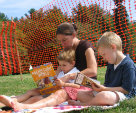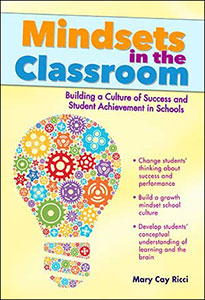Helping Students Develop Growth Mindsets
Mindsets in the Classroom: Building a Culture of Success and Student Achievement in School
By Mary Cay Ricci
(Prufrock Press, 2013 – Learn more)

Like some of my favorite professional books, this one has a conversational tone. It is no hit and run introduction to growth mindset, either. Mary Cay Ricci provides a thorough foundation in what growth mindset is, why it matters, and just as importantly, how to foster it in key stakeholders, namely teachers, students, and parents.
The lens of the gifted learner

When reading about a mindset that embraces failure on the way to ultimate success, we can easily see how struggling learners could benefit. Certainly children who have “failed” repeatedly could use the sense of possibility that comes with the mindset. But as a mom of two boys who often find schoolwork easy, I recognize the truth of what Ricci explains about children in that position.
For those to whom reading or math has always been a cinch, bumping into something hard can make a child question their self-identity as someone who is smart. To them smart might mean everything has to be easy. A few months ago my third grader sobbed because he was afraid that three wrong on his spelling pretest meant he couldn’t go to college. He was genuinely fearful because of this novel experience.
I might have seen the episode coming years ago. When he was three he came home from preschool where they’d been tracing the letters in their names. He started to draw a Q, and I praised him when I recognized the letter in his squiggly new writing. He threw up his hands and growled, “It’s not even round.” Obviously, now that I’ve learned about mindsets, his is fixed. I need more than one tool to help my son cope with life that’s going to throw more than a few spelling pretests his way.
A differentiated classroom is critical
Ricci lays out the critical importance of a differentiated, responsive classroom to a growth mindset. Her lens is one of making sure that every learner has the opportunity to learn every day. To foster and embrace a growth mindset in the classroom, topic or content area, acceleration cannot be a reward; it is a necessity for those students who have demonstrated mastery and are ready to embrace more challenge. (Stepping off my Mom Soapbox now).
I suspect that many of you wish that you could better meet the needs of all your learners, including those at the top, but your time and energy has been directed to those who struggle, because, let’s face it, the Common Core and the new high stakes assessments threaten to bring out a bit of the fixed mindset dread in all of us. And RTI legally requires us to provide significant time and support to those who have not yet mastered our content and concepts.
Ricci offers hope in the form of a plan that reflects…good teaching. She outlines the kinds of things that many teachers already do. Pre-assessment prior to instruction respects the needs of all learners if teachers take the second step of using the results to adjust what they teach next. (You probably already pre-assess. Check. You’re on your way to growth mindset teaching.)
Ricci explains the options (thank you!): acceleration or enrichment for those who already show mastery of some or all of the content. She also explains compacting and gives us permission – invites us, in fact – not to merely give extra worksheets after students have done all the regular work. Instead we can opt students out of what they already know so that they can encounter the kinds of challenges that allow them to experience frustration and learn to embrace it through their burgeoning growth mindset.
The power of failure
Ricci devotes an entire chapter to failure. In a culture driven by a belief that everyone needs to feel successful and every child gets a trophy for showing up, failure might be a third rail. As parents we sometimes strive to shelter our children from the devastating impact of failure. When in reality we’re all going to fail, possibly many times, before we succeed. It’s not the falling down, but the getting up from that failure that is important.
Ricci explains what other authors like Tony Wagner have previously described as crucial to developing innovators. Ricci cites research about intrinsic vs. extrinsic rewards and the effects of praising effort vs. product. Children (or face it, adults) who see “smart” or “athletic” or “artistic” as who they are rather than as what they do tend to internalize failure and be hurt by it. Those who attribute their success to the effort they put forth are less likely to be crushed by a setback. It hasn’t challenged who they are fundamentally, just pressed them to put forth an additional effort.
Helping parents contribute
Since parents contribute so centrally to a child’s view of the world, any effort to create a growth-mindset school needs to bring parents onboard. Like any other initiative, support from home can mean the difference between a three-color banner and a real change.
Ricci advocates teaching parents about the brain research as well as giving them tools for reflecting on the kinds of praise they use with their children. We can’t tell people how to think, nor should we. But we can offer an understanding of how different types of thinking impact the brain and behavior. The chapter also gives parents tools for sharing growth mindset with teachers, who might not be on board yet.
Raising student awareness
Many children don’t have a growth mindset yet. So as schools or teachers or parents plan to make the shift, then mindsets need to be explained to children. Ricci provides suggestions and resources for explaining the brain research and how the brain works. She offers not a single lesson but a series of experiences and tools for walking students along the path of understanding what fixed and growth mindsets are, and how they affect the way we perceive effort, intelligence and success.
Teacher professional growth
Administrators or coaches will also find this book helpful for the concrete plan it provides for professional development. Like all other human beings, some teachers already have a growth mindset and others don’t. But like parents, teachers have a major impact on the outlooks our children develop. Many of us probably have mixed mindsets. We may have a growth mindset in some areas but a more fixed mindset in others. Ricci shares just such an experience she had herself.
Mindsets in the Classroom came along just when I needed it. If you are a parent, teacher or administrator who would like to understand growth mindset more fully, or who wants to bring others along toward growing their own growth mindsets, this 150-page resource might be just what you’re looking for.
Katie Gordon, an elementary reading consultant and coach, splits her time between “building the reading capacity of my students and the teaching capacity of my colleagues.” She comes to coaching from ten years in middle and high school classrooms, during which time “I struggled to find the answers for the challenges my own students were facing.” She lives in Connecticut.



































Love it. Live it. Be it!